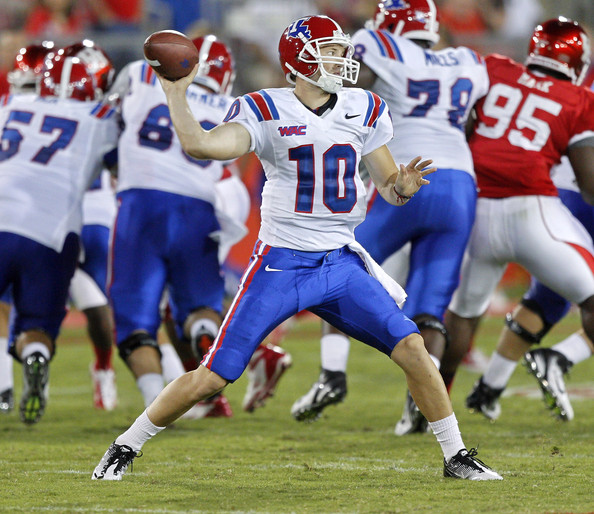Anyone remember this guy?

Turns out he was ABSOLUTELY THRIVING™ overseas playing football in Japan.
Wait?
Japan…? Seriously?
Ex NFL TE Jordan Cameron visits his younger brother&Fujitsu Frontiers QB Colby at the X League playoff semifinal game in Kawasaki on Sunday. pic.twitter.com/5vQtEcV1F0
— Kaz Nagatsuka🌏 (@kaznagatsuka) November 26, 2017
After setting records as Tech’s senior QB in 2012, Colby Cameron graduated and spent the summer of 2013 with the Carolina Panthers. When the Panthers waived him, Cameron packed his bags and went overseas to try his luck in the Japanese X League.
If you’re wondering “What the hell is the Japanese X League???” right now, I don’t blame you. Japan’s top American football league is a bizarre amalgam of customer service representatives, former American college players, and Japanese nationals. But that’s not as weird as it gets. Before we can get into Colby Cameron’s tenure as an X League GOD, I feel the need–nay, the duty–to fully explore the Japanese league’s peculiarities.
League Format
The X League was formed in 1971. It has three levels, each of which is comprised of three geographical six team divisions. So basically, the top level of the X League (X1) has 18 teams that are split into East, West, and Central divisions. X2 and X3 are also split into those same geographic divisions.
The league features what I consider to be the best thing in sports: promotion and relegation! At the end of each season, the worst team in each X1 division takes on the best team in the corresponding X2 division. The winner gets to play the following season in X1!
At this point, you’re probably thinking: “This is all fairly standard so far. Where’s the weird stuff you mentioned?”
Hold your 馬匹 !!! I’m getting there!
Okay. Qualification for the playoffs is where it gets bizarre. For clarity’s sake, we’re only going to talk about X1 from this point forward. Each season, the top 3 teams in each division form what is called the “Super 9.” The bottom 3 teams in each division form what is called the “Battle 9.” This is decided by each team’s ranking at the end of the previous season. These distinctions help to determine a team’s schedule for the upcoming season. In the X League, Super 9 teams only play games against other Super 9 teams and Battle 9 teams only play other Battle 9 teams.
At the end of the year, the top six teams from the Super 9 qualify for the playoffs based on their regular season results. The remaining two spots in the eight team playoff go to the top two teams among the Battle 9. From what I can tell, geographic division structure does not play into playoff seeding at all in the X League. So maybe this is better than the NFL?
To help explain this sort of complicated scheduling and seeding, I’ve made this handy dandy flow chart:

The playoffs are pretty straightforward. Winning teams advance, losing teams go home. All the way until the X League’s championship game, which is surprisingly named the somewhat mundane “X Bowl.” After this game, however, the X League Champion takes on the Japan collegiate national champion in a game called–no, seriously–the Rice Bowl.
Yet again, X League >>> NFL
Team Structure
If you thought the above section on playoffs and conference structure was strange, wait until I spill the beans on the truly wonderful and amazing secrets of the X League.
First of all, there are two types of teams: Company and Club. Company teams are comprised entirely of employees of the parent company. That means that every single football player for the Asahi Soft Drink Challengers must be an employee of the Asahi Soft Drink company. Club teams are less defined, and can hold open tryouts.
The fact that club teams can hold open tryouts makes it seem like they may have some sort of competitive advantage, right? Not so fast, my friend.
The Japanese X League limits each team to four total “Import” players (AKA players not from Japan). Beyond that, they limit each team to having no more than two import players on the field at the same time! For much of Cameron’s time in the X League, he played with an American running back (Gino Gordon from Harvard). So when those two were on the field together, no other foreign-born players could play with the Frontiers.
Colby Cameron: American Frontiersman
The last time we heard from Colby Cameron, he had just packed his bags and moved to Japan. When he arrived, he began working in human resources for Fujitsu Ltd. You know, the laptop and scanner company?

Fujitsu is the proud parent company of the Fujitsu Frontiers, an X1 team that plays in Kawasaki, Japan. The team’s colors are FUJITSU red, black, and white, and their mascot is Fronti the wolf.
From the team’s formation in 1985 until 2014, the Frontiers were decent, but not great. The 2000s saw them win the Eastern division four times, but they never won the X Bowl.
That is, until our boy Colby arrived on the scene. The first American quarterback to play in the X League was former-UCLA signal caller Kevin Craft in 2012. By joining the league in 2014, Colby Cameron was one of the earliest American quarterbacks in the X League.
In 2014, the arrival of Colby Cameron pioneered a new era of Frontiers football. He hit the ground running passing. In his first game, the Frontiers won 93 to 0 over the Hurricanes. In his first season, Cameron led the Frontiers to an 8-1 regular season record and to their first ever X Bowl championship over the IBM Big Blue. They also defeated the perennial collegiate champion Kwansei Gakuin University Fighters in the Rice Bowl.

In 2015, our hero led the Frontiers to a 7-0 regular season, and back to the X Bowl, but they ultimately lost to the Panasonic Impulse 24-21 in the title game. Cameron and the Fujitsu squad led 21-10 midway through the fourth quarter, but a late interception allowed the Impulse to get back into the game. Later, Cameron admitted that “I still think about it all the time,” and used the loss as motivation.
Despite this setback, Colby Cameron bounced back in a huge way in 2016. He led the Frontiers to an 8-1 record in the regular season. During the playoffs, the Fujitsu men made it back to the X Bowl, where they defeated the Obic Seagulls 16-3 and won a berth in the 70th annual Rice Bowl. During that game, which was attended by nearly 34,000 people at the Tokyo Dome, the Frontiers soundly defeated the Kwansei Gakuin University Fighters (note: KGU is seriously Japanese Bama) by a score of 30-13. For his heroics, Cameron earned the Paul Rusch Cup, given to the MVP of the X League. He also earned MVP honors during the X Bowl. When the Japan Times asked him about his MVP award in the X Bowl, Cameron replied, “Game MVP in football is kind of hard to get because it’s such a team sport. It could’ve gone to every player on our offense, it could’ve gone to the special teams. But more than the MVP, I’m happy to have won, I think that’s the most important thing. MVP is just a cherry on top.”
In 2017, Colby Cameron led the Frontiers to an undefeated season and back to the X Bowl, where they defeated the IBM Big Blue 63-23 and set a new points record for the Japanese title game. They also defeated Nihon University in the Rice Bowl, with Cameron leading the way at 20 of 27 passing for 311 yards and three touchdowns. He was named the game MVP for his efforts.
Here are the game highlights from the 2017 Rice Bowl:
[youtube https://www.youtube.com/watch?v=6RyMJdOPyj0&w=560&h=315]
Colby Cameron’s X League Stats
Retirement:
After securing the Frontiers’ third national title in four years, Colby Cameron decided to hang up his cleats and head back to America. When the Frontiers announced the news, their fans reacted on Twitter, with emotions ranging from melancholic to grateful. Here’s some of what they had to say (through Google translate):
キャメロンと、村田。。。。
推してたんだけどなぁ。。。。
寂しい。。。。お疲れさまでした。。。。
— ふるふる (@furufuru6068) March 12, 2018
“Cameron and Murata. . . . I was thinking about it. . . . It is lonely. . . . Congratulations. . . .”
キャメロンもゴードンもプレーで盛り上げてくれたし、終わったあとの写真やサインも優しくしてくれていたのが印象に残ってます。
お疲れ様でした。ありがとうございます。— ナオ=テル🏈🐴⚾🦁️🏎 🐮🎯 🧊🎮 (@Naotelu_Lions) March 13, 2018
“Both Cameron and [former Harvard RB Gino] Gordon brought up with play and the impression that the pictures and signatures after we finished gentle also remain in the impression. Thank you for your hard work. Thank you very much.”
来年はみにいけないなー pic.twitter.com/wwzQbt4sCc
— Sya (@y_sattuso) March 12, 2018
“I do not want to go next year”
コービー と ゴードンも引退か
連覇をありがとう
残ったメンバーで紡いでいきましょう— ニッター (@maitonf0338) March 12, 2018
“Will Kolbe and Gordon retire? Thank you for winning the contest. Let’s spin with the remaining members”
Conclusion
After his domination of Japanese American football, what will Colby Cameron do next? Well, his first order of business stateside was to weigh in on the Whataburger vs. In-N-Out debate raging through Texas:
Whataburger is like Cleveveland in this series… they just can’t compete with In-N-Out Burger 🍔
— Colby Cameron (@ColbyCameronBA) June 9, 2018
Next, he joined former Tech head coach Sonny Dykes on SMU’s coaching staff. At least he wasn’t around yet when Tech put the smack down on them back in December. At that time, Colby Cameron was still lighting up the scoreboard in Kawasaki.

For more on the Japanese X League and other American football leagues around the world, I recommend the website www.americanfootballinternational.com, which helped me piece together this article. I also used Japan Times articles that were thankfully translated into English without having to use google translate. For stats, I used www.american-football-japan.com





